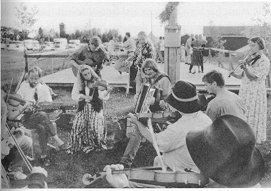|
DURING THE second half of the twentieth century folk music has
undergone a radical transformation, both concerning the sound of the music
and the form itself — what we regard as folk music. Folk music has also
attained a new status in the musical life of Sweden, which is largely due
to the rise in interest during the 1970s and 1980s. Perhaps the most vital
difference is that young people are now playing folk music to a far
greater extent than before.
The roles of the musicians have also changed, due to new demands that have
been made, both on the music itself and on the musicians. Folk music is
constantly being adapted to new media and new surroundings. We no longer
necessarily find the “typical” folk musician playing dance music at a
wedding. We are equally likely to find him leading a study group,
lecturing at a music college, performing on a concert platform or making a
CD in a recording studio. It is also quite likely that the folk musician
is not a he but a she. Roughly speaking, among the younger generations in
Sweden today as many female as male musicians play folk music, which is a
big difference compared to earlier times. The changed roles of the
musicians are also reflected in how the players see themselves. Do they
think of themselves as spelmän (the Swedish term for a traditional folk
musician), as musicians or as folk musicians if they play arrangements of
folk music on modern instrument, such as electric guitar, synthesiser or
saxophone, in a group?
 Folk
music at Övre Gärdsjö during the Lake Siljan Festival 1995. Folk
music at Övre Gärdsjö during the Lake Siljan Festival 1995.
Photo: Per-Ulf Allmo.
That an increasing number of players within the
new, popular folk music domains choose to call themselves folk musicians
reflects a new attitude, not only towards their own identity as folk
musicians but also towards the music itself.
Today we have a situation where folk music is used and created by people
with very varied backgrounds. We have a rich, flourishing fiddlers’
tradition which is perpetuated by older Swedish fiddlers as well as by a
new generation of technically skilled players who have a solid musical
training behind them. In addition to the individual musicians, folk groups
have also become a common sight on Sweden’s musical platforms.
The new styles and forms of ensemble-playing that have emerged since the
1960s are related to the development of the music industry; the
opportunities for getting to know music, both modern and traditional, from
other cultures, are greater than ever before. During the 1980s and 1990s
in particular, folk music has been characterised by enthusiastic
experimenting which has widened its domains in many different directions.
New instruments, new combinations and influences from other genres and
cultures have all made their mark on modern Swedish folk music.
|
 Folk
music at Övre Gärdsjö during the Lake Siljan Festival 1995.
Folk
music at Övre Gärdsjö during the Lake Siljan Festival 1995.